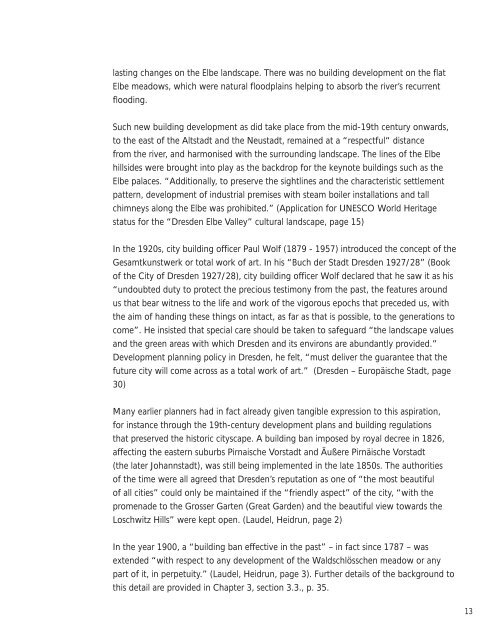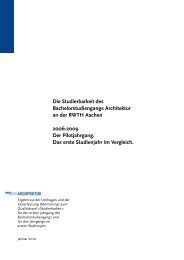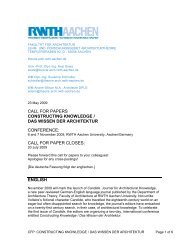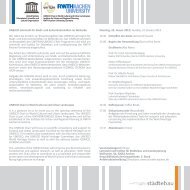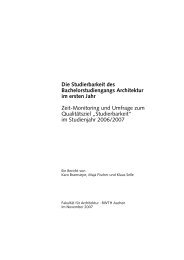Gutachten Dresden_englisch_dritte f.indd - Fakultät für Architektur ...
Gutachten Dresden_englisch_dritte f.indd - Fakultät für Architektur ...
Gutachten Dresden_englisch_dritte f.indd - Fakultät für Architektur ...
You also want an ePaper? Increase the reach of your titles
YUMPU automatically turns print PDFs into web optimized ePapers that Google loves.
lasting changes on the Elbe landscape. There was no building development on the flat<br />
Elbe meadows, which were natural floodplains helping to absorb the river’s recurrent<br />
flooding.<br />
Such new building development as did take place from the mid-19th century onwards,<br />
to the east of the Altstadt and the Neustadt, remained at a “respectful“ distance<br />
from the river, and harmonised with the surrounding landscape. The lines of the Elbe<br />
hillsides were brought into play as the backdrop for the keynote buildings such as the<br />
Elbe palaces. “Additionally, to preserve the sightlines and the characteristic settlement<br />
pattern, development of industrial premises with steam boiler installations and tall<br />
chimneys along the Elbe was prohibited.” (Application for UNESCO World Heritage<br />
status for the “<strong>Dresden</strong> Elbe Valley” cultural landscape, page 15)<br />
In the 1920s, city building officer Paul Wolf (1879 - 1957) introduced the concept of the<br />
Gesamtkunstwerk or total work of art. In his “Buch der Stadt <strong>Dresden</strong> 1927/28” (Book<br />
of the City of <strong>Dresden</strong> 1927/28), city building officer Wolf declared that he saw it as his<br />
“undoubted duty to protect the precious testimony from the past, the features around<br />
us that bear witness to the life and work of the vigorous epochs that preceded us, with<br />
the aim of handing these things on intact, as far as that is possible, to the generations to<br />
come”. He insisted that special care should be taken to safeguard “the landscape values<br />
and the green areas with which <strong>Dresden</strong> and its environs are abundantly provided.”<br />
Development planning policy in <strong>Dresden</strong>, he felt, “must deliver the guarantee that the<br />
future city will come across as a total work of art.” (<strong>Dresden</strong> – Europäische Stadt, page<br />
30)<br />
Many earlier planners had in fact already given tangible expression to this aspiration,<br />
for instance through the 19th-century development plans and building regulations<br />
that preserved the historic cityscape. A building ban imposed by royal decree in 1826,<br />
affecting the eastern suburbs Pirnaische Vorstadt and Äußere Pirnäische Vorstadt<br />
(the later Johannstadt), was still being implemented in the late 1850s. The authorities<br />
of the time were all agreed that <strong>Dresden</strong>’s reputation as one of “the most beautiful<br />
of all cities” could only be maintained if the “friendly aspect” of the city, “with the<br />
promenade to the Grosser Garten (Great Garden) and the beautiful view towards the<br />
Loschwitz Hills” were kept open. (Laudel, Heidrun, page 2)<br />
In the year 1900, a “building ban effective in the past” – in fact since 1787 – was<br />
extended “with respect to any development of the Waldschlösschen meadow or any<br />
part of it, in perpetuity.” (Laudel, Heidrun, page 3). Further details of the background to<br />
this detail are provided in Chapter 3, section 3.3., p. 35.<br />
13


